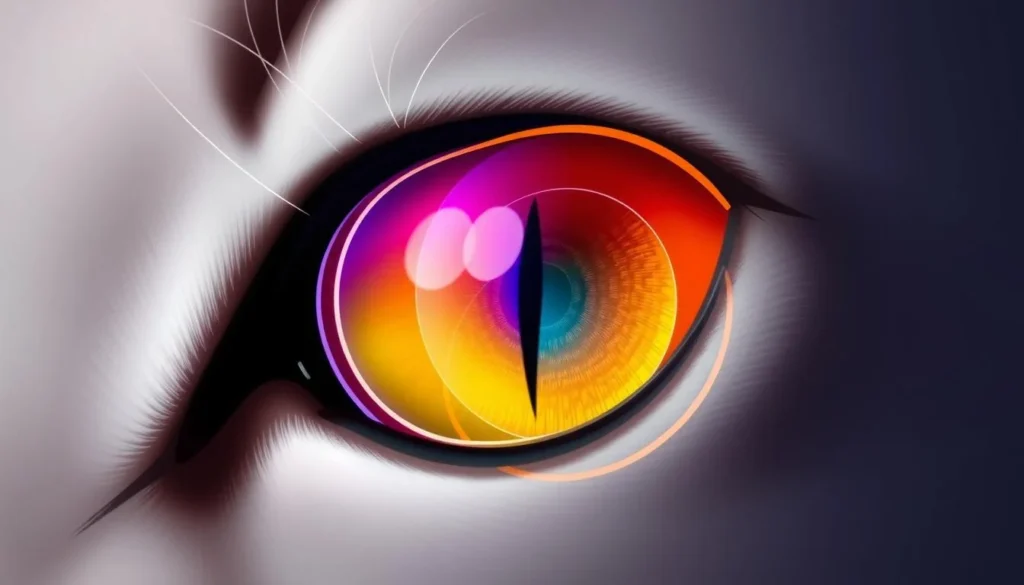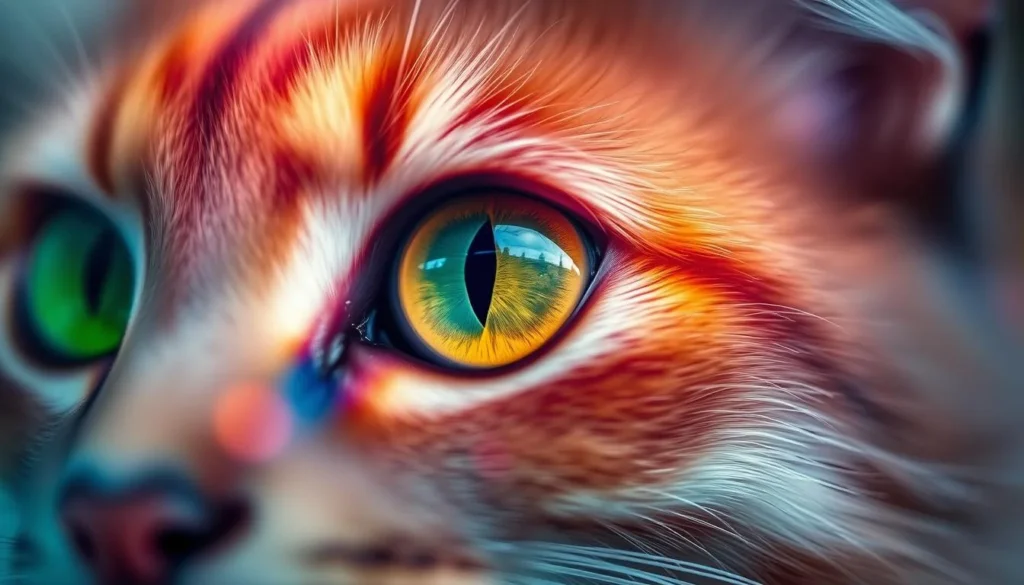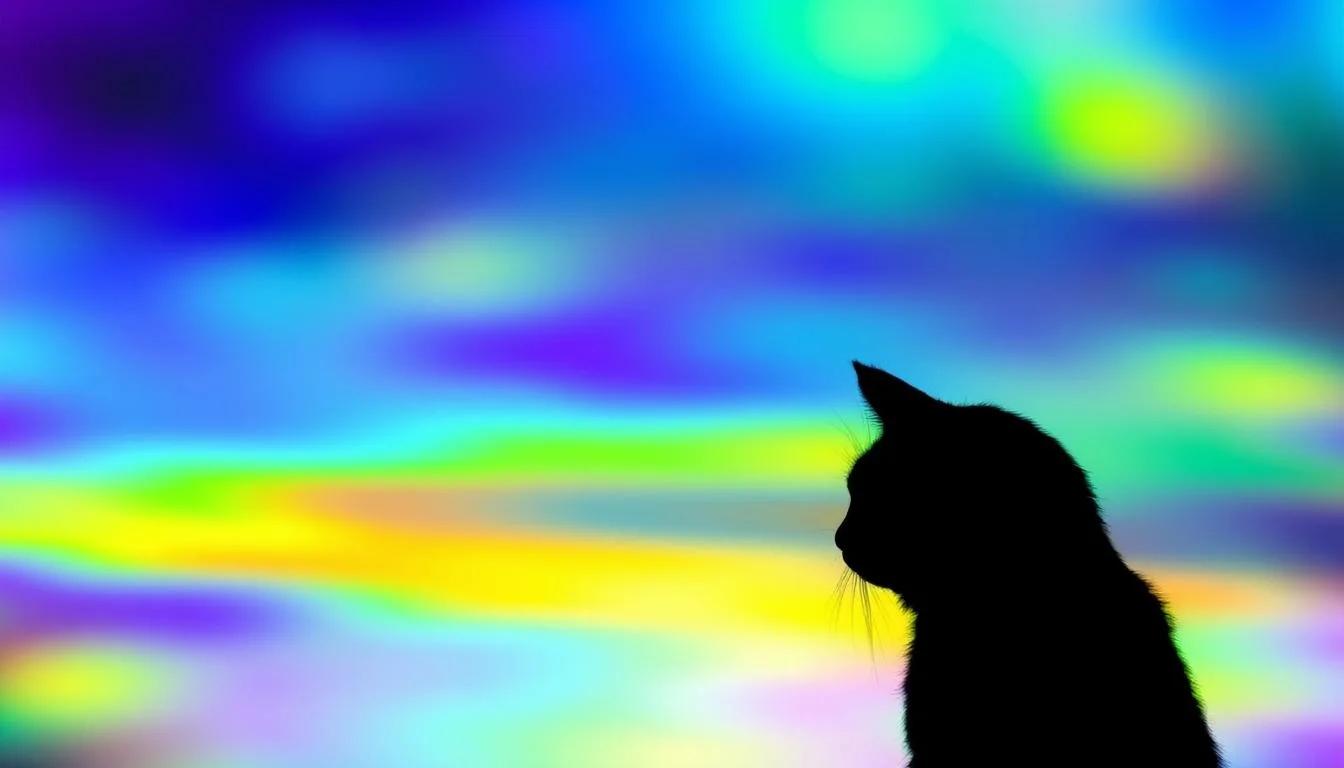Table of Contents
Ever wondered what the world looks like through your cat’s eyes? The feline vision spectrum is a fascinating realm that differs dramatically from human perception. As a cat owner, I’ve always been curious about how my furry companion experiences color and light.
Cats have a unique way of seeing the world that’s quite different from our own. Their cat vision spectrum reveals a more limited but remarkable color perception. Unlike humans, cats possess only two types of cone cells in their eyes, which means their ability to distinguish colors is more restricted.
Research into feline color perception shows that cats see the world most vividly in shades of blue and green. Red appears dull or gray to them, which explains why certain toys or objects might seem less exciting to your feline friend than they do to you. This distinctive vision is a testament to their evolutionary adaptation as skilled hunters.
Key Takeaways
- Cats have two types of cone cells, limiting their color perception
- Blue and green are the most vibrant colors in a cat’s vision
- Red appears as gray or dull brown to cats
- Cats rely more on movement and other senses than color
- Their vision is optimized for hunting in low-light conditions
Understanding Cat Vision Basics
Cats have amazing vision that’s different from ours. Their eyes are made for hunting and seeing in various lights. It’s like they have eyes designed for survival.

Every cat’s visual system is a wonder of nature. They have vision skills that help them thrive in their world.
The Structure of a Cat’s Eye
A cat’s eye is built for top performance. Here are some key features:
- Large pupils that get really big in the dark
- More rod cells for better light sensitivity
- A special layer called the tapetum lucidum
- A wider field of view than humans (about 200 degrees)
How Cats Process Visual Information
Cats see the world in their own way. They’re great at spotting movement and seeing in the dark. They have many more rod cells than humans, helping them track prey in low light.
Differences Between Human and Cat Vision
Humans have three types of cone cells for color vision. Cats have only two. This means they see colors differently:
- Blue and green are easy for cats to see
- Red and orange look muted or grayish
- Cats can’t see colors like humans do
“A cat’s vision is a testament to nature’s incredible design for survival and hunting.” – Veterinary Vision Specialist
The Science Behind Feline Color Perception

Exploring cat dichromatic vision opens a world of unique visual perception. Unlike humans, cats see colors differently. Their eyes have special retinal cones that change how they see the world.
Cat retinal cones mainly pick up on blue and yellowish-green colors. This means cats see fewer colors than humans. Here’s how their color perception works:
- Blue and green colors are most vivid to cats
- Reds and oranges seem like shades of gray
- Their vision is best in low-light conditions
Nature has adapted cats’ vision to focus on movement and light sensitivity over color richness.
Your cat’s vision is a wonder of evolution. They may not see all the colors humans do. But they are great at spotting movement and hunting in dim light. Their eyes have more rod cells than cone cells, making them excellent hunters at dawn and dusk.
Knowing about cat dichromatic vision helps you see how your cat sees the world. By choosing toys and environments that match their vision, you can make their space more fun and engaging.
What Colors Can Cats See
Cats see the world in a way that’s different from humans. Their eyes can pick up certain wavelengths that humans can’t. This makes their vision unique.
Research has shown some interesting facts about how cats see colors. Cats have two types of color receptors in their eyes. This affects how they see colors.
Blue and Violet Spectrum
Cats are really good at seeing blue and violet colors. Their eyes are very sensitive to these colors. Blue colors stand out the most to them.
- Blue is the most vivid color for cats
- Violet tones are easily detected
- Blue-violet wavelengths appear most bright and clear
Green Wavelengths
Green colors are not as intense for cats. They can see green, but it’s not as clear as blue. Darker green shades are easier to see than lighter ones.
Gray Scale Perception
Cats are great at seeing different shades of gray. They can spot small differences in shades. This helps them hunt and move around in the dark.
“Cats see the world in a palette of blues, yellows, and grays – a unique visual landscape that aids their survival.” – Feline Vision Researchers
Knowing how cats see colors helps us understand them better. It also helps us choose the right toys and environments for them.
The Role of Photoreceptors in Cat Vision
Your cat’s vision is a world of specialized cells called feline photoreceptors. These tiny sensors in the retina are key to how cats see their surroundings. Unlike humans, cats have a visual system that excels in low light, thanks to rod cells.
Cat retinal cones are quite different from human eyes. Cats have only two types of cone cells. This limits their color vision compared to humans. They mainly see:
- Shades of blue
- Green wavelengths
- Varying gray scales
The feline photoreceptors allow cats to see up to 7 times better in dim light than humans. Their eyes have 6 to 8 times more rod cells. This makes their night vision incredible, helping them hunt well.
“A cat’s vision is not about color, but about survival and detecting movement.” – Veterinary Ophthalmology Research
Even though cats see less color, their vision is amazing at detecting movement. They can spot movements up to 100 times better than humans in low light. This makes them top-notch predators.
Night Vision Capabilities in Cats
Your feline friend has amazing night vision. They can turn darkness into a hunting ground. This is thanks to their unique adaptations.
Cats can see in much darker places than humans. Their eyes are built to spot movement and find their way in the dark.
The Tapetum Lucidum Effect
A special layer in their eyes, the tapetum lucidum, helps them see at night. It reflects light back to the retina. This lets cats use over 50% of available light.
This results in a cool eyeshine when light hits their eyes in the dark.
Low Light Adaptation
Cats have more rods in their eyes than humans. This means they can see better in the dark. Their pupils also get very big to catch any light.
- Cats see best in dim light conditions
- They require objects to be more than 20 feet away for clear vision
- Their field of view spans 200 degrees
Movement Detection in Darkness
Cats can spot small movements in the dark. This skill helped them hunt during twilight hours.
“Cats are not just seeing the dark – they’re mastering it.”
Even though they can’t see in complete darkness, their eyes are incredibly well-designed.
Common Misconceptions About Cat Color Blindness
Many pet owners think cats can’t see colors at all. But, this is not true. Cats can see some colors, even though their world looks very different from ours.
Cat color blindness is often misunderstood. Studies show cats have special vision that’s different from ours. Their eyes are made for hunting and surviving in the dark.
“Cats see the world through a different lens, quite literally!” – Veterinary Vision Specialist
Here are some important facts about cat color vision:
- Cats have only two types of cone cells, compared to humans’ three
- They can see approximately 10,000 color shades (humans see one million)
- Blue and green wavelengths are most visible to cats
- Red and orange colors appear challenging for cats to distinguish
Understanding cat color vision is key. Cats focus more on movement and light than colors. Their vision is perfect for hunting in the dark.
Even though cats don’t see colors as vividly as humans, they’re not color blind. Their special vision helps them survive and thrive in many places.
How Cats Use Color Vision for Hunting
Your feline friend’s hunting skills are amazing. They use their vision to catch prey, but it’s not just about seeing colors. They are great at spotting movement, which helps them hunt better.
Cats have a special way of seeing the world. Their vision is not just about colors. It’s about how they use their eyes to hunt, making them top-notch predators.
Motion Detection vs. Color Recognition
Cats are experts at seeing movement. This skill is key for their survival. They focus more on seeing movement than on colors. This lets them:
- Spot tiny movements in low-light conditions
- Track possible prey with great accuracy
- React fast to any changes in their surroundings
Prey Identification Techniques
Cats can tell blue from green, but they mostly use movement and contrast to find prey. Their sharp vision lets them:
- See small creatures against the background
- Spot prey silhouettes
- Guess where animals will move
Visual Acuity in Different Light Conditions
“A cat’s eyes are nature’s perfect hunting equipment.” – Wildlife Expert
Cats can see well in very dark places, much darker than humans can. Their big pupils and special retinas help them hunt at dawn, dusk, and night.
Environmental Impact on Cat Vision
Your cat’s world is shaped by its surroundings. The way cats see things is key to how they interact with their space. Knowing this can help make a better, more fun place for your cat.
Lighting greatly affects how cats see things. Cats see colors differently than people do. Their eyes are made to work well in many light conditions, like dawn and dusk.
- Cats see best in low-light conditions due to their high number of rod cells
- Bright, direct lighting can overwhelm their sensitive eyes
- Soft, diffused light often provides the most comfortable visual environment
The colors around your cat can change how they feel and act. Cats mainly see blues, greens, and grays. This means their living space should focus on these colors. Some colors can excite or calm your cat, based on how they see them.
“A cat’s vision is a window into a world of subtle shades and heightened light sensitivity.” – Feline Vision Researcher
When setting up your cat’s home, think about their special way of seeing. Pick toys and places with strong contrasts and colors they can see. This makes a space that’s fun and comfortable for them, supporting their natural ways of being.
Conclusion
Learning about what colors cats can see opens a window into their special world. Cats see mainly blue and green, unlike humans. Their eyes are made for hunting, letting them spot movement and find their way in the dark.
Cats see colors differently than we do. They can’t see reds and oranges like we can. But they can spot blue-violet and yellowish-green very well. This helps them hunt better, even when it’s not light out.
When picking toys or setting up spaces for your cat, think about their vision. Blue and green toys will catch their eye more. Red and orange might look dull to them. Knowing about cats’ color vision helps make their world more fun and active.
More research is needed to fully understand how cats see the world. But one thing is sure: cats see things in a way that’s very different from us. Understanding this can make our bond with them stronger. It also helps us give them better care and fun activities.
